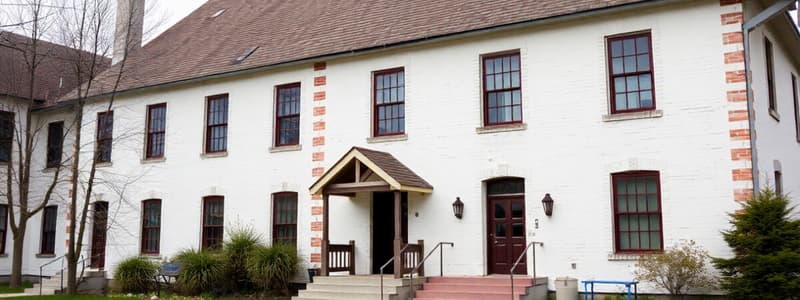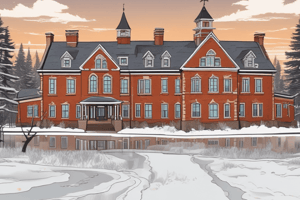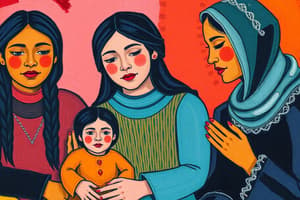Podcast
Questions and Answers
What was the primary stated goal of the Canadian residential school system?
What was the primary stated goal of the Canadian residential school system?
- To prepare Aboriginal children for employment in agriculture and trade.
- To assimilate Aboriginal children into Canadian society through education. (correct)
- To provide a basic education in reading, writing, and arithmetic.
- To promote and preserve Indigenous cultures and languages.
The Indian Act of 1876 significantly altered the relationship between the Canadian government and Indigenous peoples. What best describes this change?
The Indian Act of 1876 significantly altered the relationship between the Canadian government and Indigenous peoples. What best describes this change?
- It fostered a collaborative partnership based on mutual respect and shared governance.
- It formalized a paternalistic approach, rooted in the belief of European-Christian cultural superiority. (correct)
- It established a relationship of equals, recognizing Indigenous sovereignty.
- It ensured Indigenous representation in Parliament, giving them a voice in government policies.
What was the main recommendation of the Davin Report of 1879 regarding Aboriginal children?
What was the main recommendation of the Davin Report of 1879 regarding Aboriginal children?
- Aboriginal children should be forced to attend residential schools to assimilate them into English society. (correct)
- Aboriginal children should be given the choice to attend either residential schools or public schools.
- Aboriginal children should receive vocational training to prepare them for specific trades.
- Aboriginal children should be educated in their own communities, preserving their cultural heritage.
What was a co-operative venture between the federal government and religious orders?
What was a co-operative venture between the federal government and religious orders?
Besides assimilation not being education, what was another problem with residential schools?
Besides assimilation not being education, what was another problem with residential schools?
What was a common practice regarding the burial of children who died at residential schools?
What was a common practice regarding the burial of children who died at residential schools?
What was a common practice used to punish students for speaking their native language?
What was a common practice used to punish students for speaking their native language?
What impact did the 1951 amendments to the Indian Act have regarding child welfare services?
What impact did the 1951 amendments to the Indian Act have regarding child welfare services?
What describes the '60s Scoop'?
What describes the '60s Scoop'?
What was the main reason social workers viewed Aboriginal communities as inadequate for raising children during the '60s Scoop'?
What was the main reason social workers viewed Aboriginal communities as inadequate for raising children during the '60s Scoop'?
What was the longest running residential school in Canada?
What was the longest running residential school in Canada?
Why did the Canadian government stop keeping records of deaths in residential schools around 1920?
Why did the Canadian government stop keeping records of deaths in residential schools around 1920?
Besides poor living conditions, what was another problem at the schools?
Besides poor living conditions, what was another problem at the schools?
What kind of education did most students leave with from the schools?
What kind of education did most students leave with from the schools?
The Indian Act's unstated goal was to remove the government need to deal with what?
The Indian Act's unstated goal was to remove the government need to deal with what?
Flashcards
Residential Schools
Residential Schools
A network of government-funded, religious-order controlled schools across Canada with the goal to assimilate Aboriginal children into Canadian society.
Kill the Indian in the child
Kill the Indian in the child
An unstated objective of the residential schools, reflecting a belief in the superiority of European-Christian culture.
Mohawk Institute
Mohawk Institute
The longest-running residential school in Canada, operating from 1831 to 1970.
Indian Act (1876)
Indian Act (1876)
Signup and view all the flashcards
Assimilation (in context of Indian Act)
Assimilation (in context of Indian Act)
Signup and view all the flashcards
Davin Report (1879)
Davin Report (1879)
Signup and view all the flashcards
60s Scoop
60s Scoop
Signup and view all the flashcards
Cultural Superiority
Cultural Superiority
Signup and view all the flashcards
Forced Assimilation
Forced Assimilation
Signup and view all the flashcards
"White Man’s burden" ideology
"White Man’s burden" ideology
Signup and view all the flashcards
Separation of Families
Separation of Families
Signup and view all the flashcards
6,000 Deaths
6,000 Deaths
Signup and view all the flashcards
Cultural Suppression
Cultural Suppression
Signup and view all the flashcards
Abuse in Schools
Abuse in Schools
Signup and view all the flashcards
Study Notes
- Residential schools in Canada were government-funded schools controlled by religious orders across Canada.
- The schools aimed to educate and assimilate Aboriginal children into Canadian society.
- An unstated goal was to eliminate the Indigenous identity within the children.
History and Implementation
- From the 1600s to 1800s, attempts were made to establish residential schools run by religious orders, but most were short-lived.
- These schools aimed to convert children to Christianity.
- The Mohawk Institute in Brantford, Ontario, was the longest-running residential school, operating from 1831 to 1970.
- Early attendance was not mandatory.
- The Indian Act of 1876 established a paternalistic relationship between the Canadian government and Indigenous peoples, based on the belief in the superiority of European-Christian culture.
- The goal of the Indian Act was the assimilation of native people into Canadian society to resolve land claims and treaties and cut costs.
- The 1879 Davin Report recommended mandatory residential school attendance for all Aboriginal children.
- The aim was to separate children from their families to assimilate them into English society.
- The system was a cooperative venture between the federal government and religious orders, with the government paying and the churches running the schools.
- There was no oversight to ensure proper management.
- Boys were taught agriculture, machinery, and farming while girls were taught sewing and cooking.
- Initially, about 1,100 Aboriginal students attended 69 schools across Canada.
- At its peak in 1931, 80 schools operated in every province and territory except Newfoundland, New Brunswick, and Prince Edward Island.
- Approximately 150,000 First Nations, Métis, and Inuit children were forced to attend residential schools throughout their history.
Problems and Abuse
- Key issues included the assumption of Anglo-European cultural superiority and the prioritization of assimilation over education.
- Children were forced to attend substandard schools that had poor living conditions, were subject nutritional experiments, and faced physical, psychological, and sexual abuse.
- Students were not exposed to normal family life and were rarely allowed to see family members.
- Education was poor, with most students leaving with a grade 5 level of education or below.
- The goal was to ensure boys could do farm labor and girls could do home labor.
- Students returned home with little formal education and no traditional knowledge.
Deaths and Conditions
- It is estimated that about 6,000 children died in these schools.
- Around 1920, the government stopped keeping records due to the alarming death rate.
- Death causes included smallpox, measles, flu, TB, malnutrition, beatings, and exposure.
- Many bodies were improperly buried or hidden.
- Students were forced to cut their hair, given Anglicized names or numbers, and forbidden to speak their native languages.
- Consequences for speaking native languages include beatings or needles in tongues.
- Boys and girls were separated, including siblings.
- Food was substandard, often rotten or infested.
- Disease was rampant due to the disregard for healthy standards.
- Sexual abuse was widespread.
Later Developments
- A 1951 report detailed the problems at the schools.
- Sending children to these schools was no longer mandatory.
- The schools remained in operation for 40 more years with abusive conditions.
- Amendments to the Indian Act in 1951 gave provinces power over services not provided by the federal government such as child protection.
- Social workers were not trained to deal with Aboriginal communities, viewing them as poverty-stricken and inadequate for raising children.
- In British Columbia, the percentage of Aboriginal children in the child welfare system increased from 1% in 1951 to 34% by 1964.
- An estimated 20,000 children were taken from Aboriginal homes and placed in foster care or adopted by white families in Canada, the US, and Europe.
- These actions were often carried out without warning, done without informing tribal leaders.
- This practice, most prevalent in British Columbia, Saskatchewan, and Ontario, stopped in the 1980s.
Studying That Suits You
Use AI to generate personalized quizzes and flashcards to suit your learning preferences.




